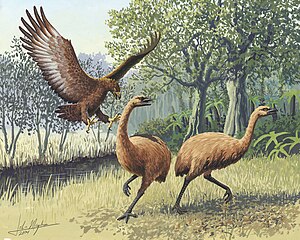Haastadler
| Haastadler | ||||||||||||
|---|---|---|---|---|---|---|---|---|---|---|---|---|

A Haast's eagle attacks Moas at |
||||||||||||
| Systematics | ||||||||||||
|
||||||||||||
| Scientific name of the genus | ||||||||||||
| Harpagornis | ||||||||||||
| Haast , 1872 | ||||||||||||
| Scientific name of the species | ||||||||||||
| Harpagornis moorei | ||||||||||||
| Haast , 1872 |
The Haastadler ( Harpagornis moorei ) was the largest bird of prey of modern times with a weight of about 10-18 kg and a wingspan of three meters . The Haastadler lived in New Zealand and mainly hunted the various moas , but presumably also various other large flightless birds, such as the South Island giant goose ( Cnemiornis calcitrans ), which weighs up to 18 kg . Together with these and other animals, Harpagornis disappeared relatively soon after the ancestors of today's Māori settled New Zealand.
Surname
The Māori called the bird Te Pouakai or Te Hokioi, whereby the second name was preferred and was probably a phonetic equivalent of the cry: Hokioi-Hokioi. There is an old Māori rock carving that shows a person with two very large, dead birds. While one probably represents an albatross , the other is seen as a representation of a harpagornis . The first scientific description comes from Julius von Haast (1874), who named it after George Henry Moore, owner of the Glenmark estate on which the bird's bones were found.
description
The harpagornis was said to be an ogre . In contrast to the moas, like many other birds of prey, it may have been purposefully exterminated . The rapid disappearance of its main prey , the moas, and other large flightless birds may have accelerated its extinction. A number of fossil finds exist , including three complete skeletons and bones carved by settlers. It is believed to be extinct along with the moa species in the 14th or 15th centuries, however there were reports of alleged sightings of great eagles until the 19th century. An eagle's nest was reportedly sighted around 1905, but this is very unlikely.
Harpagornis filled a special void in the bird-dominated New Zealand fauna, in which there were never any ground predators except for a giant gecko ( Kawekaweau gecko ) about 60 cm in size . The prey was pierced with particularly long and powerful claws , some of which pierced large bones.

He was probably waiting for prey to pass by in an elevated spot, such as a tree, and then lunging at it at high speed.
DNA analyzes show that the Haast's eagle was genetically closely related to Eurasian booted eagle ( Hieraaetus pennatus ) and the rabbit Eagle ( Hieraaetus morphnoides ) and not, as previously thought, with the Australian wedge-tailed eagle ( Aquila audax ). The branch of the Haastadler developed about 700,000 to 1.8 million years ago. The increase in dead weight by a factor of 10 to 15 in this period represents one of the fastest evolutionary increases in size that have been observed in vertebrates so far . It was believed to have been favored by the presence of large prey and the absence of other large hunters.
Web links
- GEO.de - GEOskop Giant Eagle
- Haast's eagle, New Zealand giant eagle . BBC Home, archived from the original onFebruary 28, 2009; accessed on December 3, 2015(English, original website no longer available).
- Spiegel article about Haast Adler
- NZbirds.com - Haastadler (English) and NZbirds.com - Hokioi (English)
- PLoS Biology - Report on relationship with dwarf eagles (English)
Individual evidence
- ^ A. Tennyson & P. Martinson: Extinct Birds of New Zealand . Te Papa Press, Wellington, New Zealand 2006, ISBN 978-0-909010-21-8 .
- ↑ Michael Bunce et al .: Ancient DNA provides new insights into the evolutionary history of New Zealand's giant eagle. In: PLoS Biology . Volume 3, No. 1, e9, 2005, doi: 10.1371 / journal.pbio.0030009 .